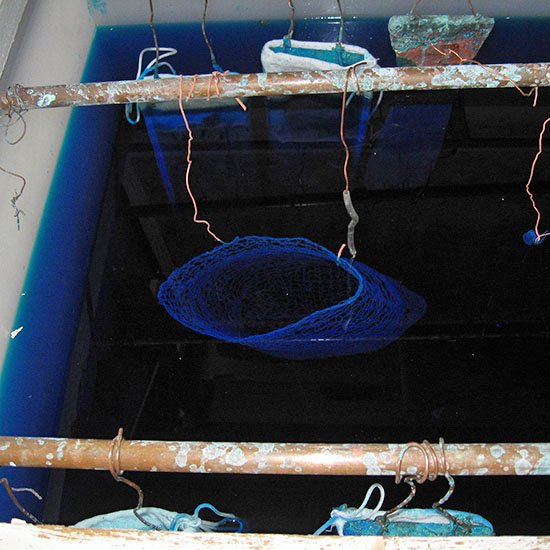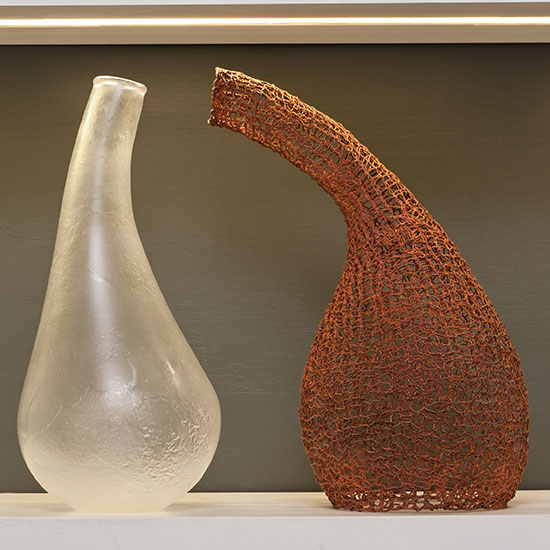Influence and Evolution: Fiber Sculpture…then and now, at browngrotta arts From April 24 – May 3, 2015 will include work by Canadian artist Carole Frève, who creates vessels of blown glass and knitted wire. “From 1995 until 1999 I worked with industrial wire nettings,” says Frève. “As I felt limited by these materials, I began to knit the wire. More or less at the same moment I began to explore the technique of electro-formed copper. In 2000, I had the idea of electroforming my copper knitting
to stiffen it and so to obtain a three-dimensional shape. Since then, I have explored several combinations of techniques to develop a personal artistic language.” Carol Fréve’s grandfather was a blacksmith in Quebec in the early 1900s, forging shoes for the horses that pulled copper from the mines. As Heather Ritchie noted in a 2007 article, ”Carole Frève: Interstices,” in Glass Quarterly, Carole was the only one of his grandchildren who would follow in his footsteps, taking up “a manual trade and working with the fire,” mixing copper and fired glass. Frève first
studied Industrial Design and after graduating in 1992, she completed a three-year glass program and Espace Verre in Montreal. Each of Frève’s vessels conducts, “a converasation with a semblance of itself,“ in Ritchie’s terms, “a conversation between what is and what appears to be; between what we are and the image we project…” Freve’s vessels of glass and knitted copper will be featured in Influence and Evolution, which opens at 3pm on April 24th. The Artists Reception and Opening is on Saturday April 25th, 12pm to 6pm. The hours for Sunday April 27th through May 3rd are 10am to 5pm. To make an appointment earlier or later, call: 203-834-0623.




Guest Post: David Ling at Haystack School of Crafts, Deer Isle, Maine
photo by David Ling
Nestled into the stoney evergreen clad ledge that seems to slip effortlessly into the atlantic off the coast of Deer Isle Maine, Haystack was to prove a desirable radical contrast to New York City, business and routine.
1000 miles, six ferries, two weeks of glass workshop, 42 haystack meals (in addition to the 10 lobster rolls en route) no cell connection and barely any online connection, the contrast was complete.
photo by David Ling
Initially drawn to haystack for its architectural and landscape setting as well as the reputation I heard over the decades of serving collectors and working with the artisans, I wanted to experience haystack for myself.The link between my architectural practice and haystack is glass. I love glass. With my Modernist Bauhaus background, I grew to appreciate and love glass. Starting with Paul Scheerbart, Bruno Taut, and the Crystal chain letters, glass took on utopian mythical proportions. Studying in Crown Hall, Mies’ glass temple to architectural education, I loved watching how the translucent glass captured light and became a filter for experiencing nature. Later, after starting my own practice, I created glass windows, glass floors, glass ceilings, glass roofs, glass furniture all using
photo by David Ling
tempered, laminated, annealed, acid etched, sandblasted, fractured glass in my work. But that’s where the similarities end. The very physical act of working with glass was to prove radically different from using glass in my architectural practice. I discovered that the very process of blowing glass requires teamwork, physical participation. Working with glass I found, required both focus and a peripheral awareness of my collaborators, heat –and not just any heat but adjusting heat with time in the air, contact with the stainless steel marver, water and wood. I found the luminous fluid quality of molten glass mesmerizing. Streams, puddles and droplets of liquid light.
In contrast to the flat planar architectural applications of glass, I learned through experimentation how glass could take on other qualities in its molten state: elastic, malleable, impervious, explosive, optical. I also started relearning how to experiment, explore and return to a childlike curiosity.
photo by David Ling
While I’m not sure how haystack will affect my future work, I am compelled by not just glass itself but how light and water play with glass. On a personal level I rediscovered child like playfulness, learning to experiment and embracing trial amd error. Collaborating with my classmates was a balletic choreography involving heat and light.
Our instructor Bo Yoon was instrumental in opening my eyes to the unique qualities of glass, not just technique.
As a class, we collectively produced a glass boat, a tree draped in glass strands, mini glass grenades, water filled glass prisms and lenses. One of the most interesting thrusts of Bo’s class and when I was most interested in was the combination of the qualities of glass interacting with water and light. With my rudimentary skills and overwhelming help from Bo, teaching assistants and fellow classmates I produced a diving bell helmet out of class. With an unobstructed view of the underwater world I could bob in the Atlantic coastal waters, listening to my own breathing and waves amplified by the buoyant glass bubble.
David Ling Architect
davidlingarchitect.com